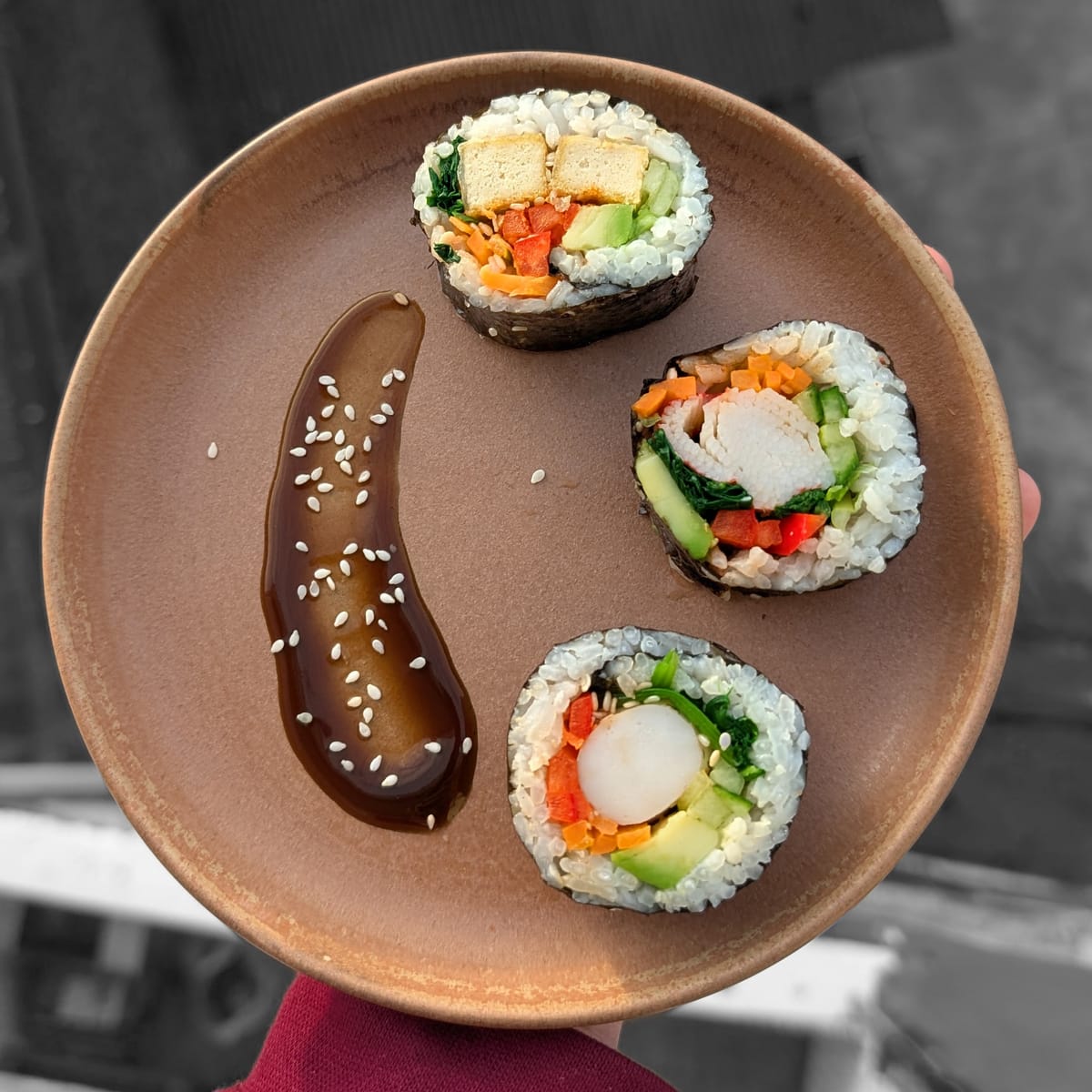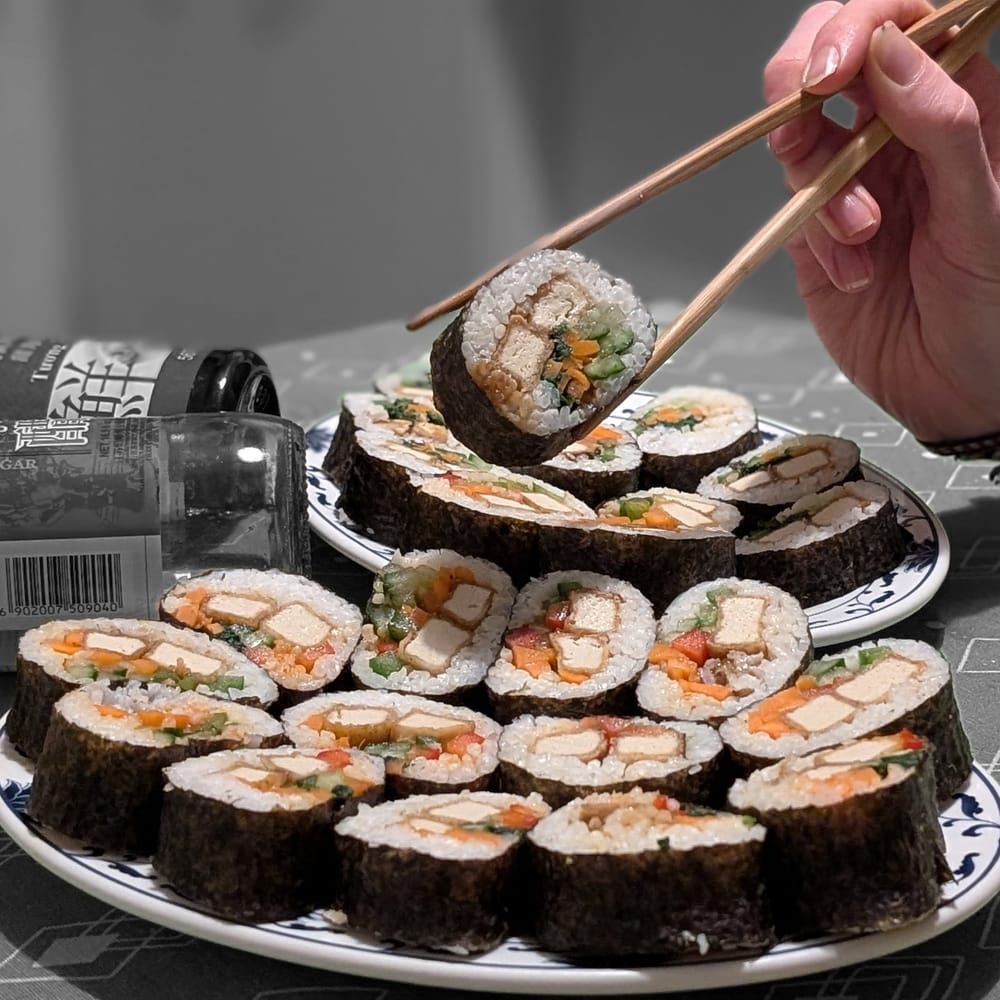Gimbap

Gimbap
€4.55 │ Serves 4 │ €1.14 per portion │30-45mins │ South Korea
Elegant, filling, and delicious! Gimbap are a South Korean staple, packed with plenty of good veg and flavour-rich protein, with choices from tofu to surimi and more.
Making gimbap is a great social activity and it's fun to eat rolls as you make them. Your first rolls might be difficult, but it's super satisfying that every roll is better than the last!
What to serve it with?
Gimbap are great on its own - all that sticky rice and densely packed ingredients are deceptively filling. However, make sure to serve gimbap with good sauces and something fresh and punchy, like kimchi, pickled ginger/radish, or seaweed salad.
Leftovers
Spoonfeed meal plans save you money by using the economy of scale. Making extra from dinner into a leftover lunch avoids spending money and extra time cooking!
Gimbap are perfect for leftovers! It is great eaten cold the next day, just make sure to take some of your preferred sauce too. As well, gimbap are visually impressive and you might get questions from colleagues asking where you got them from...
Utensils
- Saucepan
- Frying pan
- Mixing bowl
- Rice rolling mat
- And of course, chopsticks for the best experience!
Ingredients
- 5 sheets seaweed paper
- 250g sticky/sushi rice
- 3 eggs
- 1 carrot
- 1/2 cucumber
- 1/2 red or yellow pepper
- 100g spinach
- 1 tsp white sugar
- 2 tsp ground garlic
- Vegetable oil
- Sesame oil
- Rice wine vinegar
- Sriracha sauce
- Soy sauce
- Hoisin sauce
⚡ Flexible: Add your favourite protein 🍚
Gimbap are pretty flexible - you can add what you have on hand! When it comes to protein, here's some of what you could do:
- Tofu: Add tofu strips - learn our tips how to best make it yourself here +€1.19
- Surimi: Simply add in the roll +€1.59
- Tuna: Canned tuna is traditional addition +€2.50
- Vivera Kebab: A pretty versatile veggie product, can be stir fried in soy sauce to imitate thinly cut beef or pork +€3.00
- Smoked salmon: Easy to add +€4.50

Method
- Add rice to a saucepan. To be sure, follow instructions on the packet to know how much water to use. Cover with a lid and bring to a boil, then simmer for 12 minutes. Turn off and steam for 5 minutes.
- Use this time to prepare your chosen protein and slice your vegetables into long, 1cm thin julienne strips and defrost spinach, if using frozen. You can use a microwave for this if you have one, using a bowl with some water, and then drain it.
- When the rice has steamed for 5 minutes, remove the lid and fluff instantly. Combine well with 1 tbsp sesame oil and 1 tsp sugar. The rice needs to cool before use - so set it aside in a separate, room temperature bowl for it to cool faster. Making a well in the middle of the rice (leaving a bagel shape) helps the heat escape better.
- In a frying pan on high heat, sautée carrot strips in vegetable oil for about 3 minutes. Add 1 tsp garlic powder and a splash of sesame oil. After 1 minute, set aside. Next, add spinach and toast it lightly on medium heat, adding 1 tsp garlic powder. After 1 minute, splash sesame oil and cook for 1 minute. Set aside.
- Beat eggs in a mixing bowl. Add salt and pepper, then on low heat in a splash of oil add to a frying pan to make an omelette. Cook the omelette through well, and take it off the heat, cutting it into long strips, then set aside.
- With your vegetables and chosen protein prepared, set up your gimbap station. Place seaweed paper in a rolling mat - shiny side down - and your ingredients around, ready to use.
- Make a little bowl of rice wine vinegar, get ready a long, sharp knife, and a sheet of kitchen roll.
- Evenly spread about 1/5 of the rice on the seaweed paper, leaving about 5cm uncovered on the far side of the paper.
- Place your tofu or whatever you are uisng, carrot, cucumber, pepper, two or three egg strips, and spinach in the centre of the rice.
- Use both hands to roll the mat, bringing the seaweed paper and rice over the fillings. The close edge of the seaweed paper should touch the vacant far edge of the paper, leaving the fillings nicely in the centre.
- Using both hands, press the roll tightly as you continue rolling. Make sure that the mat doesn't get rolled up inside the gimbap. Push out the mat as you roll, so it doesn’t get wrapped in the gimbap. Set the finished roll aside with the seam down to seal it. If the seal is loose, run a teaspoon dipped in rice wine vinegar along the seam.
- With your knife, make confident 2cm slices through the role, cutting in one clean motion. A clean motion is key to avoiding the paper tearing and the ingredients spilling.
- Repeat by rolling another gimbap roll. Ensure that the knife is clean before cutting - rice can get starchy. To clean the knife, you can dip kitchen roll into rice wine vinegar and wipe the blade carefully.
- Serve with your preferred sides and dipping sauces - we typically use soy sauce, hoisin sauce, and sriracha sauce.
- Enjoy!
